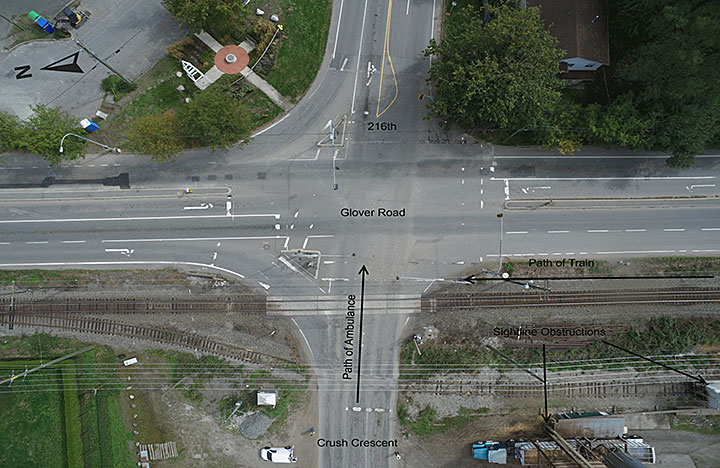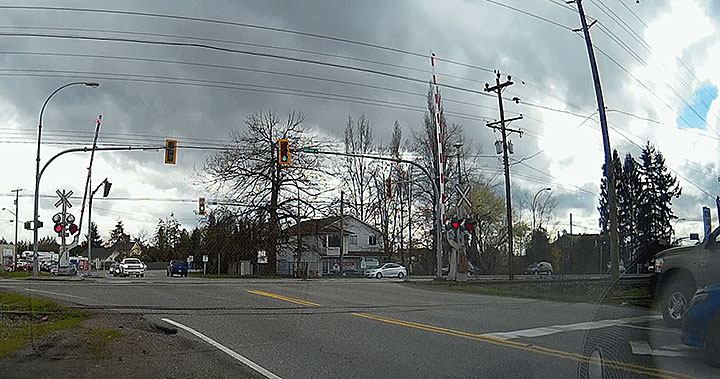Place du Centre
4th Floor
200 Promenade du Portage
Gatineau, Quebec
K1A 1K8
17 March 2016
617-07/16
R15V0191
SUBJECT:
Rail transportation safety advisory letter – 07/16
Crossing Safety at Crush Crescent–Glover Road in Langley, BC
On 11 September 2015, northboundFootnote 1 Canadian National (CN) intermodal train Q10251-11 (the train), operating at 32 mph, struck an eastbound vehicle (the ambulance) at the Crush Crescent–Glover Road crossing located at Mile 18.81 of the Canadian Pacific (CP) Page Subdivision in Langley, British Columbia. The train comprised 3 locomotives, 168 loaded container cars, measured 10,615 feet in length and weighed 10,403 tons. The occupants in the ambulance included 2 paramedics (1 driving, 1 in the patient compartment) and a patient who was being transferred to Abbotsford Hospital. The ambulance driver sustained injuries which were treatable locally. The paramedic in the patient compartment and the patient were transported by air ambulance to hospital where the patient later succumbed to injuries sustained during the collision. The train crew was uninjured (TSB Occurrence No. R15V0191).
The crossing (Photo 1) is a public crossing that is protected with automatic warning devices (AWD), consisting of flashing lights, bell and gates. The crossing AWD is interconnected with the traffic lights of the intersection. For eastbound vehicles on Crush Crescent, the sightlines to the south were obstructed by storage silos. On the day of the occurrence, several railcars had been stored in an adjacent spur track, further obstructing the view to the south. Depending on the position of an approaching eastbound vehicle, these obstructions made it difficult to see trains approaching from the south.
According to Section 19.3 of the Transport Canada Grade Crossing Standards (GCS), the interconnection of traffic signals with a warning system must: (a) provide sufficient time for vehicles to clear the grade crossing before the arrival of railway equipment at the crossing surface, and (b) prevent movement of road traffic from the intersection towards the grade crossing.
During a recent follow-up examination at the accident site, it was observed that conflicting information was being provided to motorists who were stopped at the west approach to the crossing. Specifically, it was noted that:
- During the approach of a northbound train, the AWD at the crossing was activated as designed, including the flashing lights and bell.
- Before the crossing gates started to descend, the traffic light for eastbound road traffic at the Crush Crescent–Glover Road intersection turned from “RED” to “GREEN”.
- With flashing lights at the crossing and a “GREEN” traffic light (photo 2), an eastbound motorist began to move forward, but then decided to stop and yield to the oncoming train.
The motorist was presented with conflicting information:
- The crossing warning system was indicating that there was an approaching train, which required the motorist to STOP.
- The road traffic signal was “GREEN”, indicating to the motorist that it was safe to proceed (i.e., GO).
The risks of receiving this type of conflicting information would be further exacerbated if the eastbound road traffic approaching the crossing is still in motion. The posted road speed in vicinity of the crossing is 40 km/h.
For this situation, it was further noted that:
- The crossing AWD activated and the road traffic signal changed from “RED” to “GREEN” at about the same moment.
- The crossing gates began to descend about 12 seconds after the AWD was activated.
- The crossing gates were fully horizontal about 11 seconds later.
- The time from AWD activation to the train occupying the crossing was about 30 seconds.
- The road traffic signal light had remained “GREEN” until the fourth car of the northbound train had entered the crossing.
At this crossing, changes had recently been made to the AWD, in accordance with a Notice and Order issued on 11 February 2016 by Transport Canada to the Ministry of Transportation and Infrastructure of the Province of British Columbia, the Township of Langley and the Canadian Pacific Railway. Some of the changes to the AWD include:
- The crossing gate drop delay was increased from 7 seconds to 12 seconds.
- The preemption time for the road traffic signals was increased from 10 seconds to 15 seconds.
This location presents a complex signaling challenge in which the interconnection of the AWD with the traffic signal system must safely protect vehicular traffic from passing trains. At the same time, the road traffic signals must regulate the safe flow of vehicles through this intersection. With eastbound vehicles being presented with “Stop” and “Go” commands simultaneously from the AWD and the road traffic signals, motorists may become confused. Therefore, Transport Canada, the BC Ministry of Transportation and the Canadian Pacific Railway may wish to conduct a review of the design and function of the Crush Crescent–Glover Road crossing, including a review of the interconnection between the crossing AWD and the road traffic signal system, to ensure that the risks to motorists at this crossing are minimized.
Yours sincerely,
Original signed by
Kirby Jang
Director
Investigation Operations, Rail/Pipeline
Cc:
Tanis Peterson
Director, Operations and Regulatory Affairs
Railway Association of Canada
Gerry Nera
Director, Rail and Marine ADR
Canadian Transportation Agency
Background information
Occurrence No.: R15V0191
Contacts:
Dan Holbrook
Manager, Head Office and Western Region Operations
TSB Gatineau, QC
Peter Hickli
Senior Regional Investigator
TSB Richmond, BC

